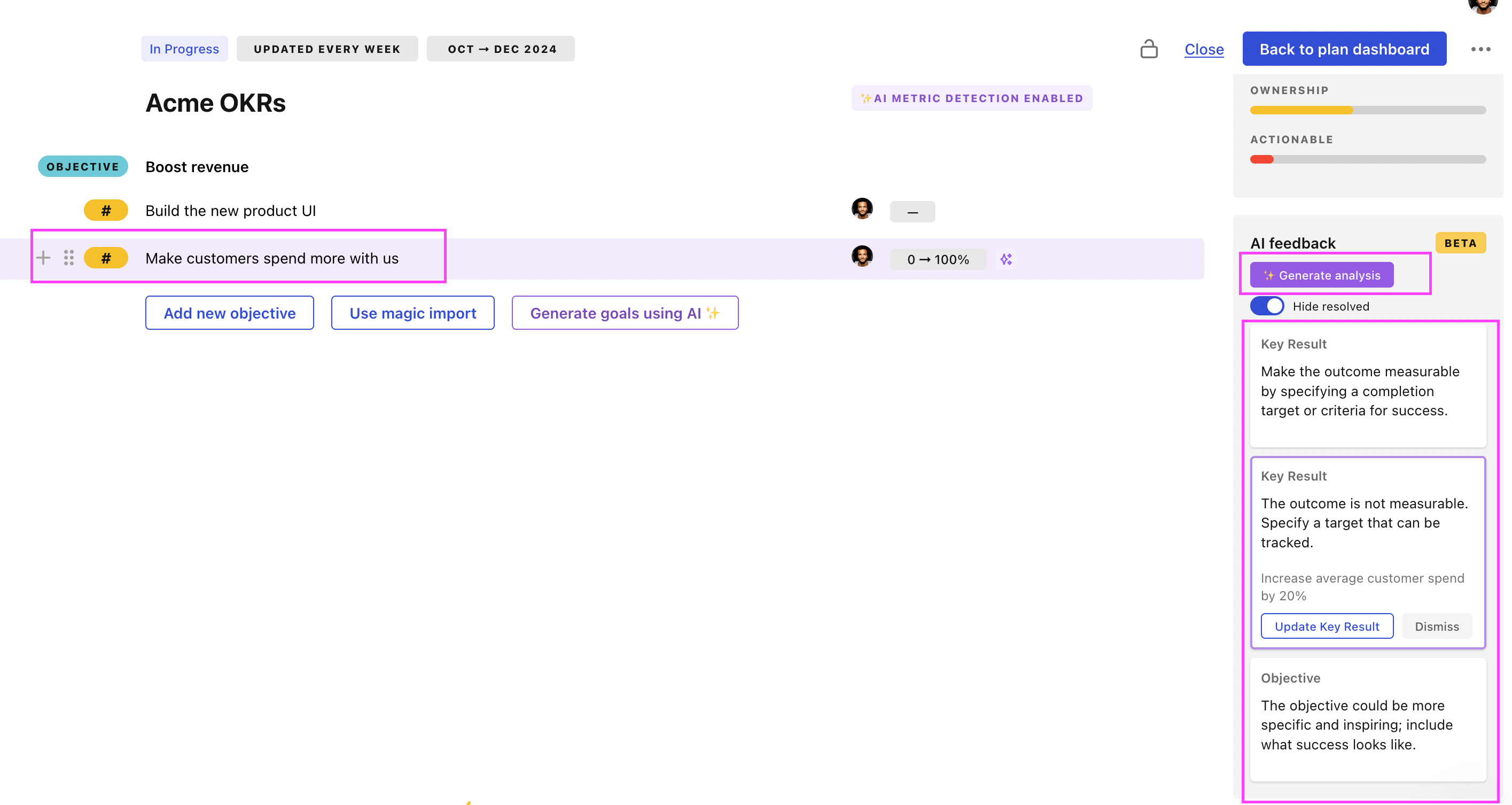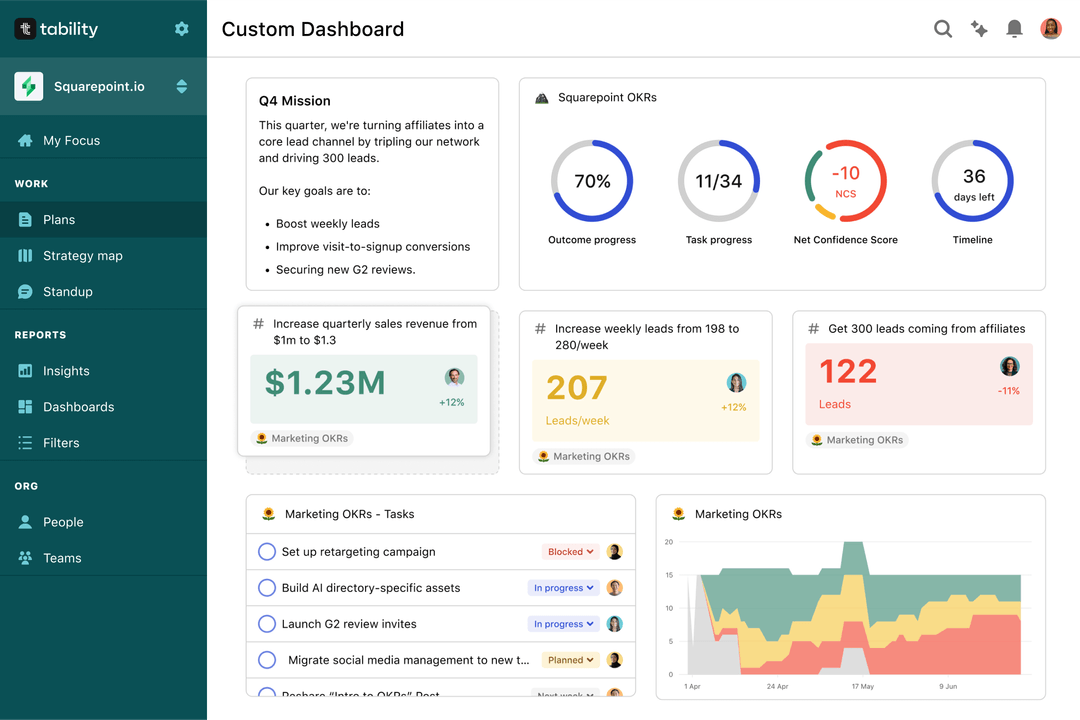Tability is a cheatcode for goal-driven teams. Set perfect OKRs with AI, stay focused on the work that matters.
What are Maintenance Team Manager OKRs?
The Objective and Key Results (OKR) framework is a simple goal-setting methodology that was introduced at Intel by Andy Grove in the 70s. It became popular after John Doerr introduced it to Google in the 90s, and it's now used by teams of all sizes to set and track ambitious goals at scale.
How you write your OKRs can make a huge difference on the impact that your team will have at the end of the quarter. But, it's not always easy to write a quarterly plan that focuses on outcomes instead of projects.
That's why we have created a list of OKRs examples for Maintenance Team Manager to help. You can use any of the templates below as a starting point to write your own goals.
If you want to learn more about the framework, you can read our OKR guide online.
The best tools for writing perfect Maintenance Team Manager OKRs
Here are 2 tools that can help you draft your OKRs in no time.
Tability AI: to generate OKRs based on a prompt
Tability AI allows you to describe your goals in a prompt, and generate a fully editable OKR template in seconds.
- 1. Create a Tability account
- 2. Click on the Generate goals using AI
- 3. Describe your goals in a prompt
- 4. Get your fully editable OKR template
- 5. Publish to start tracking progress and get automated OKR dashboards
Watch the video below to see it in action 👇
Tability Feedback: to improve existing OKRs
You can use Tability's AI feedback to improve your OKRs if you already have existing goals.
- 1. Create your Tability account
- 2. Add your existing OKRs (you can import them from a spreadsheet)
- 3. Click on Generate analysis
- 4. Review the suggestions and decide to accept or dismiss them
- 5. Publish to start tracking progress and get automated OKR dashboards

Tability will scan your OKRs and offer different suggestions to improve them. This can range from a small rewrite of a statement to make it clearer to a complete rewrite of the entire OKR.
Maintenance Team Manager OKRs examples
We've added many examples of Maintenance Team Manager Objectives and Key Results, but we did not stop there. Understanding the difference between OKRs and projects is important, so we also added examples of strategic initiatives that relate to the OKRs.
Hope you'll find this helpful!
OKRs to enhance productivity in maintenance management
ObjectiveEnhance productivity in maintenance management
KRImprove response time to maintenance requests by 15%
Conduct prioritization training for maintenance staff
Implement an online ticketing system for maintenance requests
Assign specific tasks to each staff member
KRIncrease workflow automation by 30%
Identify manual processes susceptible to automation
Implement automation software in those areas
Train staff on utilizing newly automated systems
KRReduce maintenance downtime by 20%
Regularly update and optimize machinery
Improve training on equipment usage
Implement predictive maintenance strategies
OKRs to boost the efficacy of handling maintenance requests
ObjectiveBoost the efficacy of handling maintenance requests
KRReduce the number of repeat maintenance requests by 20% through quality service enhancement
Implement quality training programs for maintenance staff
Standardize and streamline repair procedures
Introduce regular maintenance checks and reviews
KRSuccessfully resolve 90% of maintenance requests within 24 hours of receipt
Implement a robust ticket tracking system for maintenance requests
Prioritize and categorize received requests promptly
Train or hire additional maintenance staff for efficiency
KRLower the average response time to maintenance requests by 15%
Train staff to address maintenance issues promptly
Implement an efficient ticketing system for maintenance requests
Outsource tasks to competent maintenance companies
OKRs to streamline maintenance request and incident handling process
ObjectiveStreamline maintenance request and incident handling process
KRReduce response times to maintenance requests by 15%
Schedule regular preventive maintenance checks
Train staff in effective, efficient problem resolution
Implement a prioritized ticketing system for maintenance requests
KRDecrease incident closure times by 20%
Implement streamlined incident management processes
Train staff on efficient incident resolution techniques
Monitor and evaluate performance regularly
KRImprove customer satisfaction rate regarding handled incidents by 10%
Implement customer feedback surveys after incident resolution
Streamline incident response procedure
Provide staff with customer service training
OKRs to improve preventive maintenance for crucial infrastructure and equipment
ObjectiveImprove preventive maintenance for crucial infrastructure and equipment
KRImplement at least 2 new proactive care practices for 70% of critical assets
Research suitable proactive care practices
Identify critical assets needing proactive care
Train staff on new practices implementation
KRReduce equipment downtime by 15% through preventive measures
Implement regular equipment inspections for early problem detection
Establish a schedule for routine equipment servicing
Train staff on proper equipment handling and routine maintenance
KRTrain 90% of maintenance staff in advanced preventive techniques
Monitor progress and completion rates
Identify staff members needing training
Schedule necessary training sessions
OKRs to maintain and improve shadow boards for the entire department
ObjectiveMaintain and improve shadow boards for the entire department
KRDevelop and implement a weekly maintenance plan for all shadow boards
Implement and monitor weekly maintenance plan
Assign maintenance responsibilities to team members
Draft a weekly maintenance schedule for all shadow boards
KRReduce reported instances of misplaced or missing tools by 50%
Provide employee training on tool accountability
Conduct regular tool inventory audits
Implement a tool tracking system for inventory control
KRImprove organization by 30% measured via updated layout or new categorization system
Redesign workspace layout for increased productivity
Classify office supplies using a label system
Implement a new filing system for critical documents
OKRs to enhance maintenance for generator functionality
ObjectiveEnhance maintenance for generator functionality
KRImplement daily generator health check protocols by end of week 2
KRAttend at least two professional courses on generator maintenance techniques
Attend and complete both courses successfully
Register for the chosen professional courses
Research and select two relevant generator maintenance courses
KRReduce generator failure rate to under 9% by end of next period
Train staff on proper generator operation
Upgrade outdated generator equipment
Implement routine generator maintenance checks
OKRs to maintain near-perfect uptime for critical systems
ObjectiveMaintain near-perfect uptime for critical systems
KRConduct weekly preventive maintenance to prevent unexpected system failures
Repair issues identified promptly
Document any abnormalities found during checks
Schedule weekly checks on all system components
KRImprove recovery time from 30 to 15 minutes
Enhance diet for faster muscle recovery
Improve sleep patterns for better restoration
Implement quicker cooldown methods post-exercise
KRReduce system outage incidents by 20%
Upgrade outdated hardware components
Implement regular system maintenance protocols
Train staff on proactive troubleshooting methods
OKRs to maintain continuous operation of critical facilities and equipment
ObjectiveMaintain continuous operation of critical facilities and equipment
KRImplement routine checks to find and rectify faults within 24 hours
Define faults and their rectification methods
Train team in fast fault identification
Develop a daily schedule for routine checks
KRImprove response time of repair teams to equipment failures by 30%
Implement an effective communication structure among the team members
Provide comprehensive training on rapid repair strategies
Undertake regular equipment maintenance and checkups
KRAchieve a monthly average of 95% operational efficiency for all critical infrastructure
Establish key performance indicators to measure efficiency
Train staff on best operational practices
Implement routine maintenance procedures for all critical infrastructure
OKRs to optimize Agronomy Operations for a Successful PGA Tournament
ObjectiveOptimize Agronomy Operations for a Successful PGA Tournament
KRTrain staff to comply with PGA tournament guidelines, achieving 100% compliance
Monitor and track staff compliance to ensure 100%
Conduct comprehensive training sessions on the guidelines
Distribute PGA tournament guidelines to the entire staff
KRImprove golf course vegetation quality by 20% using innovative agronomic practices
Regularly assess soil health to spot deficiencies earlier
Implement sustainable irrigation methods to maintain healthy soil and vegetation
Enhance vegetation quality using bio-fertilizers and organic supplements
KRReduce course maintenance downtime by 15% through effective scheduling and resources management
Implement rigorous course maintenance schedule
Regularly monitor and adjust scheduling as needed
Allocate resources properly for seamless operations
OKRs to improve strategic smoothing for efficient production capacity
ObjectiveImprove strategic smoothing for efficient production capacity
KRBoost production output by 20% through efficiency-enhancing strategies
Implement a robust preventive maintenance schedule
Streamline the manufacturing process to eliminate waste
Train staff on time-saving techniques and productivity tools
KRReduce waste generation by 10% to improve resource usage efficiency
Initiate regular audits to identify wasteful practices
Invest in energy-efficient equipment and technologies
Implement a comprehensive recycling program in all operations
KRDecrease production downtime by 15% to enhance overall capacity
Install preventative maintenance schedule for all machinery
Upgrade outdated production equipment
Train operators on troubleshooting small issues
Maintenance Team Manager OKR best practices
Generally speaking, your objectives should be ambitious yet achievable, and your key results should be measurable and time-bound (using the SMART framework can be helpful). It is also recommended to list strategic initiatives under your key results, as it'll help you avoid the common mistake of listing projects in your KRs.
Here are a couple of best practices extracted from our OKR implementation guide 👇
Tip #1: Limit the number of key results
The #1 role of OKRs is to help you and your team focus on what really matters. Business-as-usual activities will still be happening, but you do not need to track your entire roadmap in the OKRs.
We recommend having 3-4 objectives, and 3-4 key results per objective. A platform like Tability can run audits on your data to help you identify the plans that have too many goals.
Tip #2: Commit to weekly OKR check-ins
Don't fall into the set-and-forget trap. It is important to adopt a weekly check-in process to get the full value of your OKRs and make your strategy agile – otherwise this is nothing more than a reporting exercise.
Being able to see trends for your key results will also keep yourself honest.
Tip #3: No more than 2 yellow statuses in a row
Yes, this is another tip for goal-tracking instead of goal-setting (but you'll get plenty of OKR examples above). But, once you have your goals defined, it will be your ability to keep the right sense of urgency that will make the difference.
As a rule of thumb, it's best to avoid having more than 2 yellow/at risk statuses in a row.
Make a call on the 3rd update. You should be either back on track, or off track. This sounds harsh but it's the best way to signal risks early enough to fix things.
Save hours with automated Maintenance Team Manager OKR dashboards

Your quarterly OKRs should be tracked weekly if you want to get all the benefits of the OKRs framework. Reviewing progress periodically has several advantages:
- It brings the goals back to the top of the mind
- It will highlight poorly set OKRs
- It will surface execution risks
- It improves transparency and accountability
Spreadsheets are enough to get started. Then, once you need to scale you can use Tability to save time with automated OKR dashboards, data connectors, and actionable insights.
How to get Tability dashboards:
- 1. Create a Tability account
- 2. Use the importers to add your OKRs (works with any spreadsheet or doc)
- 3. Publish your OKR plan
That's it! Tability will instantly get access to 10+ dashboards to monitor progress, visualise trends, and identify risks early.
More Maintenance Team Manager OKR templates
We have more templates to help you draft your team goals and OKRs.
OKRs to streamline and speed up our manufacturing process
OKRs to deepen understanding of audience content preferences
OKRs to successfully complete the construction progression course
OKRs to enhance individual skill set through learning and development
OKRs to implement robust data privacy compliance framework
OKRs to expand design team to drive revenue growth